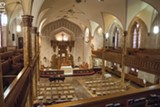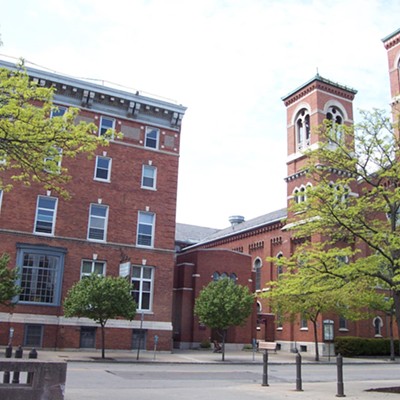[
{
"name": "500x250 Ad",
"insertPoint": "5",
"component": "15667920",
"parentWrapperClass": "",
"requiredCountToDisplay": "1"
}
]
Tucked away in the upper frame of some of the windows at the Episcopal Church of St. Luke & St. Simon Cyrene are old, worn blinds. They're hard to see, because the balcony drops down slightly over the windows, but they're what remain of coverings drawn during the blackouts of WWII. The church, with its hidden blinds, secret doors, and faux finishes, is as rich in oddities as it is in history.
Located on South Fitzhugh Street downtown, it's a Gothic Revival structure built in 1824 to serve the small Episcopalian congregation of St. Luke. It was co-founded by Nathaniel Rochester, and it's registered as a city, state, and national historic landmark.
It's the city's oldest building still in use, says Cynthia Howk, architectural research coordinator for the Landmark Society of Western New York.
"When that building was constructed, this was Rochesterville," Howk says. "It was probably the most important house of worship in this area at the time."
But Two Saints, as it's often called today, is in trouble and is showing signs of significant deterioration. The building needs roughly $250,000 in repairs, with somewhere between $75,000 and $100,000 needed soon just to replace the roof, Larry Steffler says. Steffler formed Friends of Historic Two Saints, a non-profit that he hopes will be able to raise enough money to prevent the building from falling into further disrepair and begin a long road to restoration.
"The roof is a priority," Steffler says. "We need to seal the outside envelope of the building and stop the leaks."
There's every reason to preserve this architectural gem, Howk says. St. Luke & St. Simon Cyrene is not like some of the grander churches in the city. As you approach St. Luke & St. Simon Cyrene, its simple stone steps rise from the sidewalk on a site that's oddly tranquil despite its center city location. The building looks as if it could have been plucked from somewhere in the British Isles.
Much of the main building was constructed from gray limestone, with red Medina sandstone for the quoins – the large corner stones of the building. The stone, however, is spalling, a kind of cracking and flaking that allows moisture to penetrate the stone and worsen with time. The building was expanded in the late 1820's, and in the mid-1800's the original bell tower was raised up and rebuilt to form a gabled belfry.
Once inside, the building's pointed windows, a hallmark of Gothic Revival architecture, line the length of both sides of the church in a brilliant display of color.
The windows are made of stained glass using a hand-painted technique that was common in the US at that time, says Howk. "But it's not the stained glass we think of today," she says.
More than 15,000 diamond-shaped pieces of glass were painted and fired in a kiln multiple times, says the Rev. Keith Patterson, rector for St. Luke & St. Simon Cyrene. The result gave the clear glass of the windows a grainy, grayish appearance and intensified the colored glass with a smokier look. The windows are bordered in repetitive medieval patterns of grape leaves, lilies, and oak leaves.
The Gothic Revival design is also seen in the tracery plaster above the cross, triple-tiered pulpit, and wood canopy, says Patterson. Much of the wood was burnished and faux painted so that its grain looked uniform even though different types of wood were used at the time, he says.
St. Luke's first organ was installed in 1832, and the church was the first in the city to have one.
But the historical significance of St. Luke isn't limited to its architecture and design. Though many African Americans were Episcopalian at the time, houses of worship were segregated. St. Luke was built for a white congregation. St. Simon Cyrene, on Oregon Street, was founded roughly 100 years later, and most of its congregation was African-American. The churches served followers who shared the same city, but not the same prayer space.
That changed in 1988, when the congregations of the two churches merged. A chapel located in Tyler Hall, an addition to the original building, houses artifacts from St. Simon Cyrene, including stained glass windows. One, with an image of a white Jesus, is believed to be a Tiffany. Patterson is trying to get it authenticated.
The chapel also houses a columbarium, where the ashes of some of St. Simon Cyrene's former parishioners are held. In front of the columbarium are two handmade kneeling pillows, with designs commemorating the merger: one depicts the two churches while the other shows a cross held up by two people, one black and the other white.
St. Luke & St. Simon Cyrene looks deceptively small from the street, but its rambling addition has spacious rooms on multiple floors that are essentially vacant except for a few offices for church staff.
"We've got to find a way to make better use of this space," says Friends of Two Saints' Steffler. The space is available for events, such as wedding receptions, but he speculates that at least some of it could be rented to other organizations to help raise money to pay for the restoration costs.
But Two Saints has the same struggle many other churches have. An April 2017 article in The Atlantic noted that "Americans – long noted for their piety – were fleeing organized religion in increasing numbers."
And a 2017 Baltimore Sun article on church closures and mergers says: "Membership at churches and synagogues has fallen by nearly 20 percentage points since World War II, according to Gallup. The Episcopal Church and Presbyterian Church USA have lost nearly half their members since 1967."
Locally, the Rochester Catholic Diocese downsized during the last 20 years, closing some of its churches and schools.
It's not lost on Patterson that the culture war of the 1990's and 2000's wasn't good for business.
"We have about 100 or so people walk through those doors on Sunday," he says, "and I want them to know that they will be greeted, that all are welcome, no exceptions."
Further complicating matters, funds for restoring houses of worship are anything but abundant. Steffler is trying to show that Friends of Two Saints has a track record of raising money on its own and is a credible candidate for grants, he says.
The church has taken a small but rather unusual step for churches today to help raise its profile: the doors to St. Luke & St. Simon Cyrene are literally wide open Tuesday through Friday from 10 a.m. to noon so that anyone can look inside the church, come in, and spend a few moments there. Most churches lock their doors after services are over.
But Patterson says he wants the public to see what they have in St. Luke & St. Simon Cyrene.
"This is truly a treasure that needs to be preserved," he says. "It would say something about our community if we didn't."
Latest in News
More by Tim Louis Macaluso
-

RCSD financial crisis builds
Sep 23, 2019 -

RCSD facing spending concerns
Sep 20, 2019 -

Education forum tomorrow night for downtown residents
Sep 17, 2019 - More »






